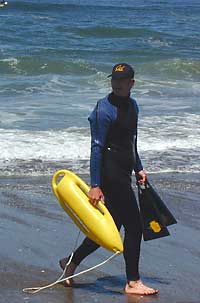Berkeley - Swimmers, waders, dog-walkers and beachcombers
at San Francisco's Ocean Beach, beware.
 |

Francis
James Smith at Ocean Beach Robert Sanders,
photo |
The
beach is notorious for its rip currents, and the fast-moving
rips that have formed already this season represent a hazard
to the unwary, warns Francis Smith, a University of California,
Berkeley, graduate student in geography who has studied
local rip currents for the past five years. Smith also is
a swimmer, diver and former National Park Service lifeguard
at China Beach.
"Ocean
Beach is the most hazardous and dangerous piece of shoreline
associated with an urban environment in the whole United
States," he said today (Thursday, May 23) at a media briefing
in the parking lot at Ocean Beach in an effort to publicize
the danger.
Last
month, three swimmers were swept out from shore by rip currents
at Ocean Beach, and one had to be rescued by firefighters
and the Coast Guard, with the help of a nearby surfer. Those
unfamiliar with the ocean, as well as non-swimmers swept
off their feet by waves, are carried to sea and drowned
each year.
"In
1998 more than a dozen people drowned there," Smith said.
"I want to help prevent drownings, so I'm warning people
that these rip currents are already in place and will persist
through the summer."
Rip
currents are fast, outgoing streams of water that can quickly
sweep swimmers far from shore. They are distinguished from
rip tides, which are bores that travel up and down river
mouths and estuaries with the tide.
According
to the United States Lifesaving Association, in 2000 more
than 22,000 people were rescued from rip currents in the
United States, out of a total of nearly 71,000 rescues.
About 80 percent of lifeguard rescues at the country's surf
beaches involve people caught in rip currents, the association
claims.
Knowledgeable
swimmers can escape rip currents by paddling parallel to
the shore until free of the current, then heading toward
the beach. Surfers love them, however, as a freeway through
the surf zone to get set for the next wave.
"To
surfers, these fast currents are like streetcars, but the
currents are a danger to those who don't understand them,"
said Robert Wiegel, professor emeritus of coastal engineering
and Smith's advisor. "There are dangerous rip currents at
beaches around the world, and most heavily used beaches
in urban environments have lifeguards. Ocean Beach's beach
patrol, with trained lifeguards, has done an excellent job
preventing drownings."
"Usually
rip currents don't go out much beyond the surf zone, but
at Ocean Beach the surf zone is big," Smith said. One satellite
image of the San Francisco area shows a rip current that
seems to stretch a quarter mile into the ocean.
Smith
has been fascinated by the currents at the beach for years,
and four years ago convinced the city of San Francisco to
post warnings about rip currents along the Great Highway,
which borders Ocean Beach. He designed a series of four
beach hazard symbols and beach hazard signs that earned
him a certificate of appreciation from the United States
Lifesaving Association in 1999.
Working
with the late geographer Bernard Nietschmann at UC Berkeley,
he wrote a master's thesis on Ocean Beach rip currents,
and currently is working on a PhD thesis delving into why
rip currents occur where they do.
Typically,
the currents at Ocean Beach dissipate during the winter
and reappear in spring, Smith said. He has tried to capture
on video the appearance and disappearance of the rip currents,
and first observed them forming this year in April. He also
recently obtained spectacular footage of a lineup of rip
currents at Baker Beach, north of Ocean Beach and within
sight of the Golden Gate Bridge.
He
hopes eventually to put together a packet with video to
educate people about where and how the currents form at
Ocean Beach.
Rip
currents are generated, Smith said, when waves hit a section
of beach that deflects the water into a fast, seaward trough,
which funnels through a channel in an underwater sand bar
that prevents the water from retreating back the way it
came. Rip currents are often associated with a small underwater
sand bar, frequently visible at extremely low (negative)
tide, and they probably reinforce one another, Wiegel said.
The
outgoing current can reach speeds of up to six miles per
hour - nine feet per second - which is faster than an Olympic
swimmer, Smith said. Typically 25 to 150 feet wide, they
dissipate only after passing through the surf zone, perhaps
hundreds of yards offshore.
"Rip
currents are caused by different things, and Francis is
trying to sort out the causes at Ocean Beach," Wiegel said.
"But he primarily wants to help minimize drownings. If alerting
people can save just one life, he's doing a good job."
More
information on rip currents can be found on the Web site
of the United States Lifesaving Association, http://www.usla.org.